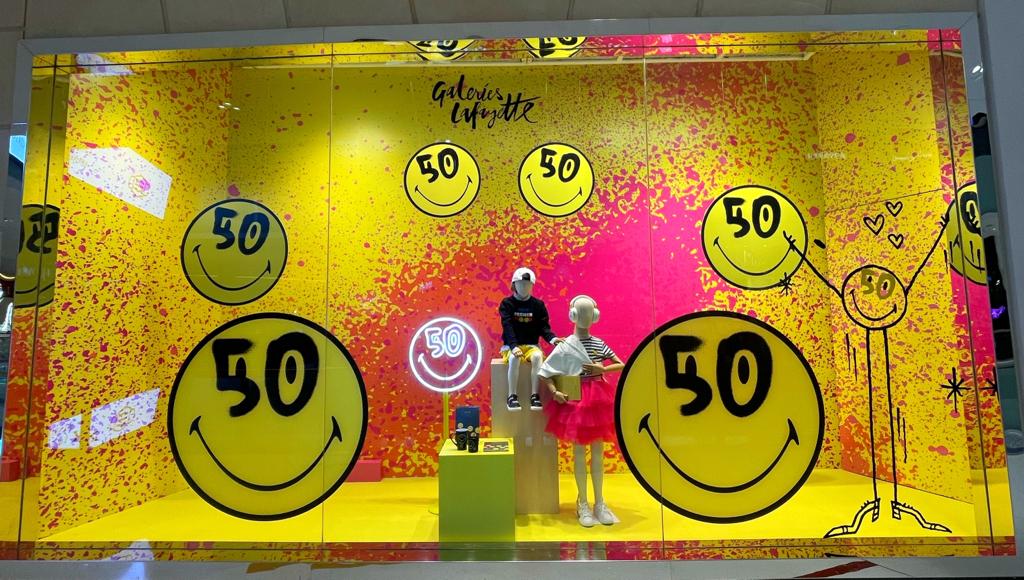Many of the artworks are vibrant in their form, yet often bleak in their content. Some critique our current social and economic condition with sharp wit, while others playfully invite us to join in on the joke. Yet, all of them engage with a dystopian reality that is characterised by our inability to escape the confines of various systems of control. However, as is common within the dystopian genre, the ultimate motive is not to despair, but to envision different paths for a better future.

Circling Drones (Iraq), From A Feast in the Ruins Series, 2022
Embroidery on shizen rag paper 200g, Mixed media.
Courtesy of the artist and Dalloul Art Foundation
Works such as those by Selim Mawad (Lebanon) provide a critical commentary of Lebanese politics and people. In this collection, both the tropes and the shared sufferings of Lebanese society become the main protagonists of these irreverent pieces. His art addresses issues such as the country’s brain drain or the Beirut recent tragic explosion, while condemning the Lebanese political landscape and their handling of infrastructure and economic upheaval.
On a more global perspective, Hady Sy’s (Lebanon) works critique and challenge the role that numbers and money play in our lives. In the Sifr/Zero (2014) series, Sy highlights the abstract nature of numerical values and their significance in our lives, while in the Al Khawarismi (2015) pieces he replaces George Washington’s image with an illustration of Al Khawarismi, the Baghdad-based 9th-century polymath, known as the father of algebra, in an homage to the mathematician’s contribution to modern mathematics, particularly in his establishment of zero as a numerical placeholder.

Untitled 1 (Policemen on Motorbikes), 2009
Inkjet on archival paper
Courtesy of the artist and Dalloul Art Foundation
Hope in an Age of Dystopia is fundamentally an invitation to imagine a different mode of resistance. It does not ask the viewer to ignore reality, but it also asks them not to fall into nihilistic despondency. In many of the pieces, this perspective is brought forth through choice of colour and material, where the bright vibrancy of the works is in communion with the starkness of the content presented. This is exemplified in works such as Amer Shomali’s (Palestine) Broken Weddings (2018), a reconstruction of traditional patterns of Palestinian brides’ wedding dresses (thobe) left behind during the 1948 Nakba (Arabic for “catastrophe”). The alignment of the spools highlights the vibrancy of the colours used in the dresses, while simultaneously symbolising a grave yard, reflecting the catastrophe of loss and displacement.

The Coverts, 2023
Mixed media on canvas.
Courtesy of the artist and Dalloul Art Foundation
Similarly, in Johanne Allard’s (Lebanon/Canada) works from the series A Feast in the Ruins (2022), moth metal sculptures and embroidered pieces point at the devastation of systematic attacks to the Levant and Arab region. Despite the themes being portrayed here, one is left with the sense of hope that Allard’s works exude. They acknowledge the unjust realities of life in the region, while also celebrating the continued survival of the culture and all it carries in terms of intimacy, community, and resilience.

Al Khawarismi, 2015
Inkjet print on fine art paper.
Courtesy of the artist and Dalloul Art Foundation
There is a profound sense of vulnerability throughout the artworks and the materials used: delicate and intricate stitching of a harrowing reality, dazzling embroidery of nature overcoming, rusty and repurposed metal moulded into expression, bright neon witticisms, and concrete futurisms.
All works occupy the same space and ask us to come to terms with our present reality in order to move past its confines. Yet, every single piece acknowledges a fundamental truth: that intimacy, connection, and communication are the way our hopes can come to fruition.

Wheat, 2021
Mixed media, mixed media on metal.
Courtesy of the artist and Dalloul Art Foundation
About the Dalloul Art Foundation
The Ramzi and Saeda Dalloul Art Foundation (DAF) is a Lebanon-based arts institution dedicated to preserving and showcasing modern and contemporary Arab art.
Established in 2017 by Dr Basel Dalloul, the foundation’s roots trace back to his late parents, Dr Ramzi Dalloul and Saeda al-Husseini, who started collecting art in the early 1970s. They purchased art they loved, created by artists with whom they had formed personal connections over the years. Viewing artists as “the keepers of truth and archivists of history”, they acquired a collection of nearly 3,000 pieces, showcasing the diversity of modern and contemporary Arab art. The collection was initiated as “a labour of love”, which Dr Basel has the honour of continuing.
Courtesy of Dalloul Art Foundation
Through public programmes, exhibitions, online publications, archiving and research, the Dalloul Art Foundation aims to introduce modern and contemporary Arab art to local, regional and international audiences.
The Dalloul Art Foundation has extended the accessibility of its collection and resources to regional and international audiences with the launch of dafbeirut.org. The foundation opens its doors to researchers and doctoral students, offering access to its extensive resources, collection management system, and internal research facilities to support their academic studies.
For more information, please visit www.dafbeirut.org.





